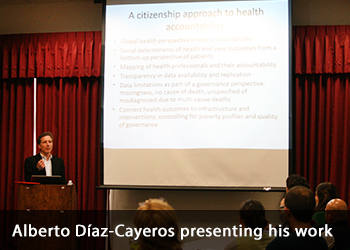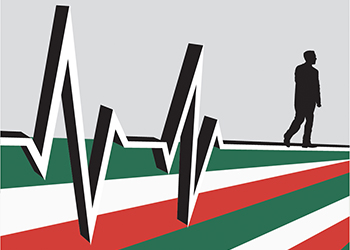Alberto Díaz-Cayeros, former director of the Center for U.S.-Mexican Studies (USMEX), returned to the research center Dec. 4 for a presentation on his continuing work surrounding public health in Mexico. The research, co-presented by Melissa Floca, current associate director for the Center, and PhD candidate Micah Gell-Redman, also served as a call for outside scholars to access, interpret and use the data.
 In an effort to create the Atlas of Governance of Public Health in Mexico, Díaz-Cayeros, Floca and Gell-Redman worked with numerous collaborators to map and document the location of health centers throughout the country. Then, they began organizing and documenting death records, taking the summer in what Díaz-Cayeros said was a “massive effort."
In an effort to create the Atlas of Governance of Public Health in Mexico, Díaz-Cayeros, Floca and Gell-Redman worked with numerous collaborators to map and document the location of health centers throughout the country. Then, they began organizing and documenting death records, taking the summer in what Díaz-Cayeros said was a “massive effort."
The purpose, he said, was two-fold: to provide a citizen-based approach in looking at local-level health outcomes, and a platform for further research.
“We wanted to create a clearing house where data would become available,” he said. “We really need to empower citizens to be able to demand response from their health providers.”
In terms of “years of life lost,” a method the group uses that factors in life expectancy and actual age of death, Díaz-Cayeros presented analysis of specific causes of death from 2000 and 2010. He was quick to say the data was promising, showing improvement in health outcomes, overall.
However, concerning years of life lost for specific groups, these outcomes appear to have worsened. The presentation linked some of this negative change to an increase in violence related to the drug trade.
“This data lets us look at very specific groups,” Floca said. “We can view men who are between the age of 15 and 45, who have a low level of education and live in violent areas in the north of the country, and many of those guys are not going to make it to an age where they will die of diabetes or of heart disease because they’re dying of homicides.”
Díaz-Cayeros reiterated the point, saying there is a “profound crisis” in Mexico for young men, not only from assaults, but also from suicides and cirrhosis. Combined, these far outweigh life lost to either heart disease or diabetes.
“As we think about this data, we can start zeroing in on what’s going on at the local level. We really want to invite people to discover what the implications are in specific states,” he said. “There are some places, for example, where things like ‘self harm’ are incredibly important as causes of years of life lost. What’s going on in those places?”
Taking the discussion further, Díaz-Cayeros encouraged researchers and policy makers to use the atlas to analyze what he called “social determinants” to the health outcomes. For instance, does the higher level of cirrhosis indicate a higher degree of drinking and, if so, does this also influence the number of automobile accidents? What can be done?
“One of the things we are trying to do with this is to move away from just counting deaths,” he said. “We are trying to figure out, not just the patterns of disease, but also what are called the ‘risk factors’ as we move forward in public health.”
With several papers being discussed overall, this is just one effort in ongoing research the Center is doing with the online atlas, a multi-year project launched in 2010 through the support of the Hewlett Foundation. For more information, launch the Atlas of Governance of Public Health in Mexico.
